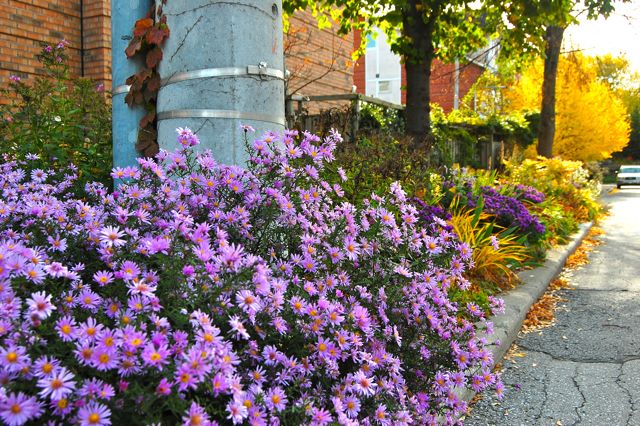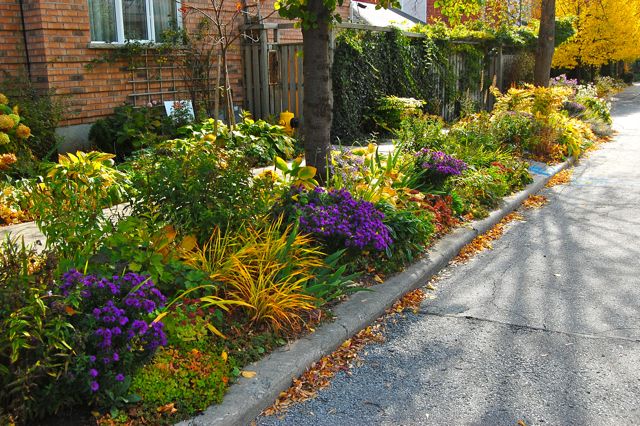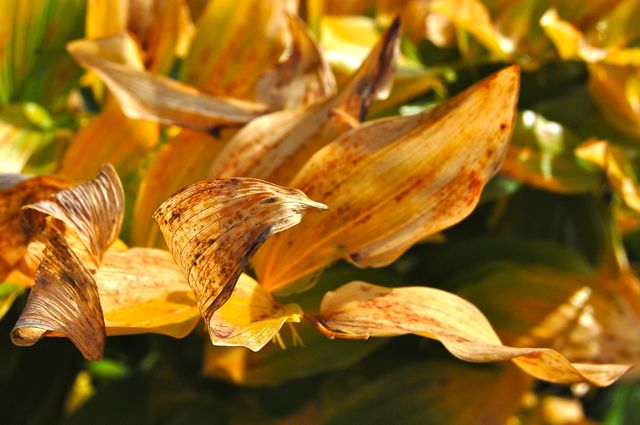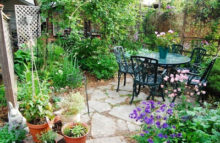The good-things-come-in-small-packages garden of Paul Geary, he of Petal Pushers garden therapy, is around the corner and down the street. To compensate for the petite size of his own garden, Paul has made his city-owned boulevard strip a thing of beauty. Right now the strip is a particularly fetching bouquet of purple and gold.
See how the repetition of the same deep purple draws your eye along the strip? Purple asters (Symphiotricum) complement repeated golden fall foliage in different textures, from the gold in the neighbour’s linden tree (Tilia cordata), to the grassy daylilies (Hemerocallis) and the taller, arching stems of the Solomon’s seal (Polygonatum) below.
Solomon’s seal is one of my favourite architectural plants, with interest through the growing season. In late spring, the stems sport rows of small pendant white flowers, and the leaves often wear pearls of water after a rain.
For variety, Paul has selected flowers in closely related (analogous) shades of pink and mauve, along with white. While mixing and matching unrelated colours would have made a rich fall display, it wouldn’t have given the garden the same unity.
That ability to pull your eye through makes a small space seem larger. From this angle, for instance, some of the purple repetitions are hidden. Compare this to the effect in the second image. Still beautiful, but without t
hat je ne sais quoi (except now you do sais quoi: it doesn’t have the same pleasing rhythm.)
Elements to repeat include texture, colour, form and scale, through foliage, flowers, ornamentation, or hardscaping. Once you get the hang of it, you can mix it up by repeating something in different materials. Maybe it’s spheres of clipped box, round flower heads of globe thistle (Echinops) and, hey, even bowling balls!
Why not? If something is good, it’s usually worth repeating.








10 comments
Repetition is important! Repetition is important! Repetition is important!
Thanks for visualizing this critical lesson in garden design.
I was just thinking about this topic yesterday as I was tending to a client's garden. I had been asked to to plant an encyclopedia of perennials and the lack of rhythm and repetition was starting to upset me now that the plants had reached maturity.
Guess what I will be doing in her garden next spring?
Great post!!!!
Good lesson. Since deer like to eat so many things around here, I have stuck to a few basics. I guess they helped me in a way to plant the same stuff over and over. Who knew I was following a plan?
Lovely colors in this fall garden you showed.
I love this (and I love Allan's comment). I don't follow repetition myself, but I have a bigger chaos going on here, and that calls for drifts, not so much repetition.
(heh. I just gotta share this. My word verification is gropeth. The mind boggleth.)
I love this little garden bed! It certainly shows how repetition should be used and the unity and flow it gives in the garden! Great post, great lesson! Thank you!
Jodi – a drift is repetition, just keeping it in the family ;>)
Yup, I'm definitely a fan of the repeats! I'm trying to do that in my gardens, too. Your pictures are especially pretty, good work.
You are right, Helen! This is a good principle and repetition is something I aim for … the trouble is that our weather is so chancy the attrition rate is pretty high. All the so-carefully placed lambs ears and salvias are dead, so what's repeated, alas, is empty space. On the other hand, there was a place to plant the Bluebonnet seeds.
Annie at the Transplantable Rose
I am working on providing repetition in my garden. I was also interested to see that he makes use of substantial clumps, not a 1-2-3-1-2-3- repetition of small clumps. Beautiful border.
Helen, You have such a talent for explaining important principles simply and clearly. I already knew that repetition is important, but this helped me to think about how to create rhythm in a more intentional way. Thanks! -Jean
The use of flowers is amazing, absolutely beautiful. Even the grassy daylily leaves are stunning this time of year